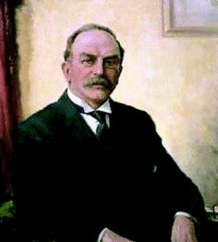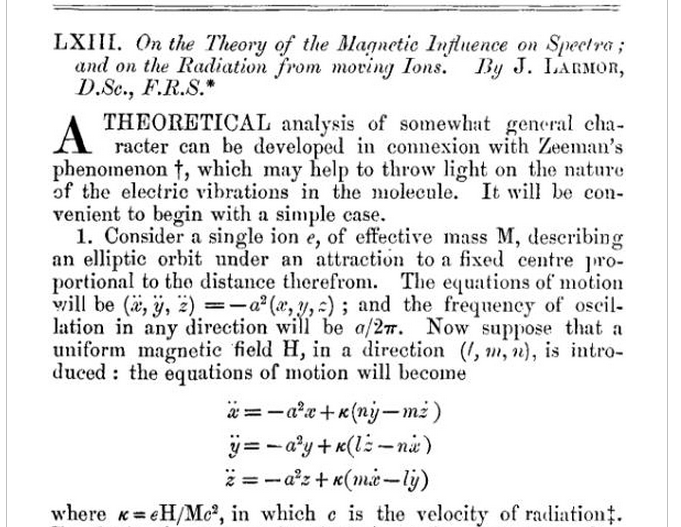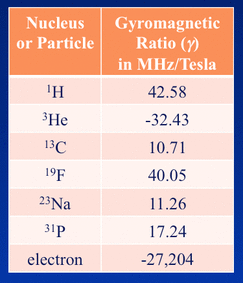Sir Joseph Larmor was an Irish-born mathematical physicist whose career spanned from the late 19th to the early 20th Century. For many years he served as the Lucasian Professor of Mathematics at St. John's College, Cambridge. His contemporaries included such notables as J.J. Thomson, Lord Kelvin, and James Clerk Maxwell.
Larmor worked in an era when the basic structure of the atom was still being elucidated and quantum mechanics had yet to be developed. His famous equation of 1897 had nothing to do with NMR, as this phenomenon was still several decades away from being discovered. Instead it arose from attempts to explain the curious splitting of optical spectral lines by an external magnetic field described by Pieter Zeeman one year previously.
Larmor's theory was that Zeeman's spectral lines were produced by charged particles (electrons) moving in elliptical orbits. Larmor demonstrated mathematically that these electrons should precess around the direction of the applied magnetic field. He further calculated that the frequency of precession was directly proportional to the strength of the applied field times a constant. Larmor's constant was directly related to the particle's charge/mass ratio.
Larmor's theory was that Zeeman's spectral lines were produced by charged particles (electrons) moving in elliptical orbits. Larmor demonstrated mathematically that these electrons should precess around the direction of the applied magnetic field. He further calculated that the frequency of precession was directly proportional to the strength of the applied field times a constant. Larmor's constant was directly related to the particle's charge/mass ratio.
|
In later years as more became known about atomic structure, Larmor's equation was found to apply to any particle with spin or angular momentum, taking the form we recognize today:
fo = γ Bo
where fo is the precession frequency, Bo is the strength of the externally applied field, and γ is the gyromagnetic ratio, a constant specific to each specific nucleus or particle.
The table (right) gives values of the gyromagnetic ratio (γ) for various nuclei and particles. Negative values for γ mean that direction of precession is opposite to that of ¹H. |
We see from the table that among nuclei, ¹H has the highest gyromagnetic ratio. The resonance frequency of any particle at a certain field strength can easily be calculated using this table and the Larmor equation. For example, in a field (Bo) of 1.5T, the resonance frequency of ¹H would be (42.58 MHz/T) x (1.5T) = 63.87 MHz. At 3.0T the resonance frequency would be twice as fast, or 127.74 MHz.
By comparison, an the precession frequency of an electron in a field of 1.0T would be 27,204 MHz (or 27.204 GHz) and in a direction opposite to that of ¹H. Thus to study electron paramagnetic resonance (EPR) frequencies in the microwave region must be used.
By comparison, an the precession frequency of an electron in a field of 1.0T would be 27,204 MHz (or 27.204 GHz) and in a direction opposite to that of ¹H. Thus to study electron paramagnetic resonance (EPR) frequencies in the microwave region must be used.
Advanced Discussion (show/hide)»
No supplementary material yet. Check back soon!
References
Bruen R. Sir Joseph Larmor. 2007. (http://www.lucasianchair.org/20/larmor.html)
Larmor J. LXIII. On the theory of the magnetic influence on spectra; and on the radiation from moving ions. Phil Mag 1897; Series 5, Vol 44 (271): 503-512.
Tubridy N, McKinstry CS. Neuroradiological history: Sir Joseph Larmor and the basis of MRI physics. Neuroradiology 2000; 42:852-855.
Bruen R. Sir Joseph Larmor. 2007. (http://www.lucasianchair.org/20/larmor.html)
Larmor J. LXIII. On the theory of the magnetic influence on spectra; and on the radiation from moving ions. Phil Mag 1897; Series 5, Vol 44 (271): 503-512.
Tubridy N, McKinstry CS. Neuroradiological history: Sir Joseph Larmor and the basis of MRI physics. Neuroradiology 2000; 42:852-855.
Related Questions
All the NMR books all show protons precessing like little tops or gyroscopes within the magnetic field. I don't really understand why this type of motion should occur. Can you explain?
Why does the RF-field have to be applied exactly at the Larmor frequency for resonance to occur?
All the NMR books all show protons precessing like little tops or gyroscopes within the magnetic field. I don't really understand why this type of motion should occur. Can you explain?
Why does the RF-field have to be applied exactly at the Larmor frequency for resonance to occur?



